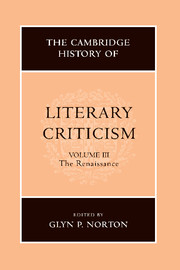Book contents
- Frontmatter
- Introduction
- READING AND INTERPRETATION: AN EMERGING DISCOURSE OF POETICS
- POETICS
- I Humanist classifications
- II The rediscovery and transmission of materials
- 9 Literary imitation in the sixteenth century: writers and readers, Latin and French
- 10 Petrarchan poetics
- 11 Translatio and translation in the Renaissance: from Italy to France
- 12 Invention
- III Rhetorical poetics
- IV Literary forms
- THEORIES OF PROSE FICTION
- CONTEXTS OF CRITICISM: METROPOLITAN CULTURE AND SOCIO-LITERARY ENVIRONMENTS
- VOICES OF DISSENT
- STRUCTURES OF THOUGHT
- NEOCLASSICAL ISSUES: BEAUTY, JUDGEMENT, PERSUASION, POLEMICS
- A SURVEY OF NATIONAL DEVELOPMENTS
- Bibliography
- Index
- References
12 - Invention
from II - The rediscovery and transmission of materials
Published online by Cambridge University Press: 28 March 2008
- Frontmatter
- Introduction
- READING AND INTERPRETATION: AN EMERGING DISCOURSE OF POETICS
- POETICS
- I Humanist classifications
- II The rediscovery and transmission of materials
- 9 Literary imitation in the sixteenth century: writers and readers, Latin and French
- 10 Petrarchan poetics
- 11 Translatio and translation in the Renaissance: from Italy to France
- 12 Invention
- III Rhetorical poetics
- IV Literary forms
- THEORIES OF PROSE FICTION
- CONTEXTS OF CRITICISM: METROPOLITAN CULTURE AND SOCIO-LITERARY ENVIRONMENTS
- VOICES OF DISSENT
- STRUCTURES OF THOUGHT
- NEOCLASSICAL ISSUES: BEAUTY, JUDGEMENT, PERSUASION, POLEMICS
- A SURVEY OF NATIONAL DEVELOPMENTS
- Bibliography
- Index
- References
Summary
In the European Renaissance the term invention has many senses, several of which inform poetic theory and literary criticism: a ‘discovery’, a ‘finding’, the ‘faculty of discovery’ but also the ‘thing found’; something close to ‘imagination’, ‘wit’, and positively or pejoratively a ‘technique’ or ‘artifice’. Dominating the concept of poetic invention is the meaning of inventio in (mainly Latin) rhetorical theory. The noun inventio corresponds to the verb invenire [to find, to discover, to come upon]. In rhetorical treatises, at the place of invenire we often find reperire [to find, to discover] or excogitare [to think of, to find by reflection]. The most lucid and accessible account of the process of ‘finding’ that informs rhetorical composition is given by Cicero, in his De partitione oratoria (especially 1.3-2.5). The orator derives his ‘power’ [vis] from two sources: first, his res (the ‘things’ of the speech: subject-matter, including both ideas and facts); second, his verba (the words chosen to convey subject-matter). The finding of subject-matter precedes the finding of words, and although inventio is sometimes loosely applied to both kinds of finding, generally inventio concerns only subject-matter, not words, which are the province of elocutio [eloquence]. In composing a speech the orator has in mind an aim, an intention (quaestio: either unlimited, in the sense of a general enquiry, or specific, a causa). In order to achieve this aim, the orator must find subject-matter that will both convince his audience (literally, produce faith, confidence, or belief, fides, in those he wishes to persuade) and move the audience's emotions.
- Type
- Chapter
- Information
- The Cambridge History of Literary Criticism , pp. 136 - 144Publisher: Cambridge University PressPrint publication year: 1999
References
- 4
- Cited by



